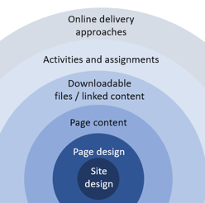Discover Bookshelf+
September, 30, 2025 • Less than 1 minute read
This semester, Bookshelf+ went live for select publisher-approved titles, bringing a new generation of study tools directly into the Bookshelf® eReader platform that students...
September 18, 2025 • 1 minute read
By: Mike Hale, Ph.D., Chief Learning Officer
July 2, 2020 • 4 minute read
“I had to make a choice,” she said. “I had enough time and energy to struggle with inaccessible content and complete my degree, or I had enough energy to sue the University for failing in their anticipatory duty. I didn’t have enough energy for both.”
This was a specific email exchange with the student. It provides an insight into what the Public Sector Bodies Web Accessibility regulations aims to achieve where previous legislation failed.
The legal background
In Australia, the Commonwealth Disability Discrimination Act 1992 (DDA) ensures that it is unlawful for an education provider in Australia to discriminate against a person on the ground of the person's disability, and in Europe, the European accessibility act works to ensure fewer barriers when education for those with a disability. Similarly, since 1995, the law in the UK has protected disabled people against discrimination by enshrining their right to “reasonable adjustments”. This has worked well in the physical world with ramps and doorways, but in the digital world, the barriers faced by disabled people have been largely ignored, not least because nobody was sure what was a “reasonable” level of accessibility to achieve.
In 2018 new legislation for the UK was passed. For the first time, it defined a “reasonable adjustment”.
“A failure by a public sector body to comply with the accessibility requirement is to be treated as a failure to make a reasonable adjustment.” Section 12
From September 23rd, 2020, the Public Sector Bodies Web Accessibility regulations require high accessibility standards (Web Content Accessibility Guidelines 2.1 AA) on all public sector websites - including further and higher education institutions. In addition, organisations must provide an accessibility statement that outlines in plain English the extent to which they have (or have not) met the legislation.
This is a huge paradigm shift. Until now, the responsibility was on a disabled person to request accessible content. The timescales, energy and frustration involved in doing this - perhaps hundreds of times - meant it was often easier to simply put up with the extra workload caused by inaccessible content.
This is no longer the case. A disabled student no longer has to wonder whether their next handout, presentation or e-book will be accessible. It is the responsibility of the institution to ensure that it is. And if it isn’t, it is the responsibility of the institution to use the accessibility statement to signal the fact, explain what they’re doing about it and who to contact for a solution.
The onion of accessibility
The key problem with most organisations is that digital technologies and digital content are increasingly significant parts of the student experience but “digital accessibility” belongs to nobody. In reality, it has to belong to everybody. I often use the concept of the “onion of accessibility” to show how the student experience depends on many nested factors.
At the heart of the onion is the design of the website/learning platform. Here, technical decisions impact on accessibility features like magnification reflow, colour contrast, keyboard navigation and so on.
At the next level out, page design choices will often be made at departmental level. Some page types and behaviours are much more accessible than others. You can have a highly accessible site design undermined by poor page choices at course level.
Even when people with technical knowledge ensure the site design and recommended page templates are accessible, the text, images and links within the page content can be highly accessible or highly inaccessible depending on the knowledge and skill of the tutor creating the content. Equally, the downloadable files like Word documents and PDFs can vary significantly in their accessibility. PDFs in particular can have very unpredictable magnification, reflow and reading order issues. Linked content like videos, podcasts, e-books, and journals can add significant accessibility for some users but can also create unintended barriers for others. Activities like quizzes, discussion threads and collaborative tasks add huge accessibility value and open up new assessment opportunities. But if naïvely chosen, they can create barriers for particular users.
Finally, when much of the content is now delivered online, consideration needs to be given as to how online delivery impacts on disabled people. Many of the impacts will be positive, and these can be exploited and built on. Some will be negative.

Figure 1 - The onion of accessibility
Checking progress and priorities
Digital accessibility consists of so many elements that it can be hard to “see the wood for the trees”. Ultimately it is about culture change and professionalism. In a 21st century institution where digital tools are part of everybody’s daily experience and all staff are involved with digital content or communication, creating barrier-free content should be part of every job description. But culture change does not happen overnight. With AbilityNet, I have created a simple Accessibility Maturity Model. It allows organisations to self-assess through 8 different cultural lenses. This can be an effective way of helping different parts of the institution identify gaps. It helps to focus on priorities that will result in sustainable changes.
For Further Education organisations looking for staff training and inspiration, the Enhance Digital Teaching Platform has a wealth of free, short training activities complete with free webinar recordings on inclusive practice. There is also a free badging process for developing skills in accessibility and inclusion.
For Higher Education and Further education, the free Future Teacher training resources are all about 21st-century digital practice. There are specific modules on accessibility and inclusion themes but every one of the modules has digital accessibility woven through it, for example, Designing appropriate assessments, Designing for technology enhanced programmes or the Wonderful world of webinars.
If you’re struggling to even know where to begin, make sure you have joined the Jiscmail Digital Accessibility Regulations mailing list as well as the Jisc moderated Accessibility Community group in the UK. Also follow the Centre for Accessibility and the Australian Network on Disability in Australia. If you require expert input on the accessibility of your systems then AbilityNet’s Digital Accessibility Bundle is worth considering as a starting point.
About Alistair:
Alistair McNaught has worked in a national capacity providing advice and guidance on digital accessibility to universities and colleges since 2004. He was responsible for steering the 2016 crowdsourced eBook accessibility audit and the 2018 ASPIRE audit of publisher and platform accessibility statements. He now works as an associate on the textBox ASPIRE service as well as working extensively in higher and further education.
September, 30, 2025 • Less than 1 minute read
By: Blake Perdue, Director, Product & Learning Platforms
This semester, Bookshelf+ went live for select publisher-approved titles, bringing a new generation of study tools directly into the Bookshelf® eReader platform that students...
September, 18, 2025 • Less than 1 minute read
By: Mike Hale, Ph.D., Chief Learning Officer
September, 9, 2025 • Less than 1 minute read
By: Rachel Van Campenhout, Ed.D., Senior Research Scientist
When I began my research partnership with Dr. Autry at Cal Poly Pomona, we did so with the aim of investigating a question of teaching and learning: how might the addition of...
We want to provide the best experience for customers worldwide.
By selecting a location, you will be directed to that region. Switch your location at any time by checking 'Select Location' in the top right.